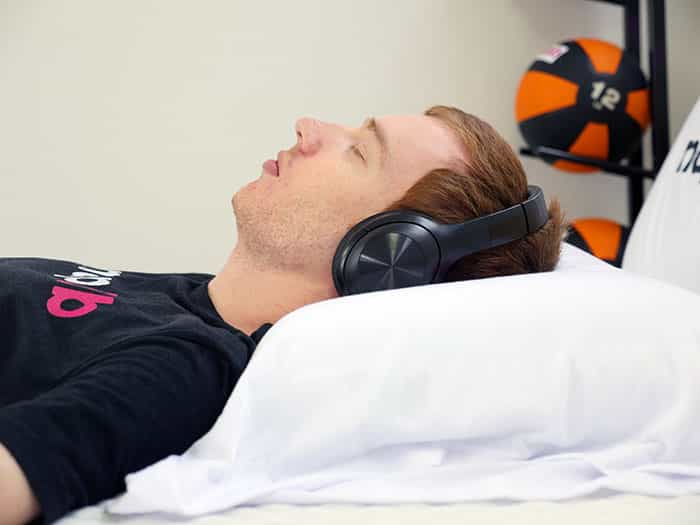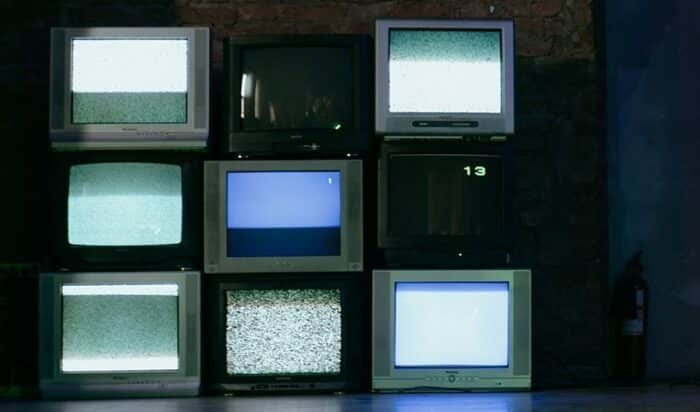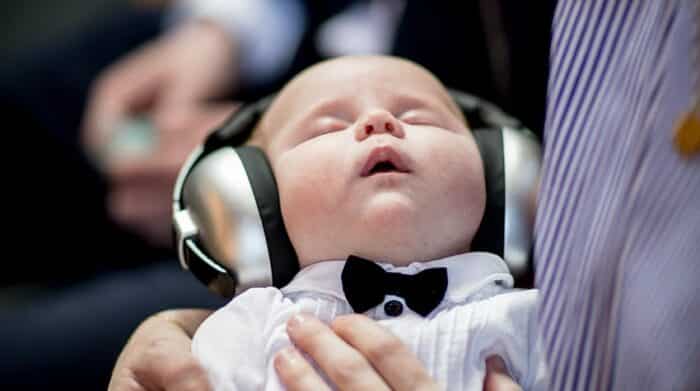Have you ever pondered whether it’s more beneficial to slumber in silence or with background noise? The answer hinges on your sleep surroundings and individual requirements.
If you reside in a cacophonous locale or share your sleeping space with someone who has a different timetable, you may discover that white noise is advantageous. This type of sound can cloak ambient noises, leading to a more profound sleep. It may also enhance cognitive performance, mental concentration, and memory.
However, what exactly is white noise and how does it contribute to sleep? Are there any downsides? Let’s delve into these questions.

Drifting off while listening to white noise has become a widespread phenomenon on the internet, with a multitude of advertisements showcasing “white noise” devices and applications. These products mimic the sounds of rainfall, gusts of wind, ocean waves, and more. Users can blend them together to concoct personalized soundscapes that assuage stress, soothe the mind, or evoke emotions.
According to Live Science, white noise refers to random sound that can mask other environmental sounds. Its intensity remains constant across the audible frequency spectrum, encompassing all frequencies.

Sound travels in waves. “Frequency,” as defined by the National Park Service, denotes the number of times a wave repeats in one second (cycles) and is measured in hertz (Hz). A single hertz equates to one cycle per second. The normal range for hearing frequency is 20 to 20,000 hertz.
Experts from Texas A&M Health highlight the impact of environmental noise on sleep. They recommend utilizing white noise devices to obstruct external sounds that hinder proper rest.
White noise is also purported to alleviate symptoms of ADHD, tinnitus, and other medical ailments. However, the research in this area is inconclusive.
Certain studies suggest that it might have more negative effects than positive ones. We will further delve into these aspects shortly, so continue reading.
The presence of background noise can be either beneficial or detrimental, contingent on its frequency and volume. The latter is measured in decibels (dB). Prolonged exposure to sounds surpassing 70 decibels may compromise hearing, as per the Centers for Disease Control and Prevention’s warning.
Sounds like rustling leaves, ocean waves, gentle rainfall, and household appliances such as refrigerators generally register below 50 decibels and possess a low frequency.
Waterfalls represent a form of auditory interference produced by the forces of nature. Machines designed to generate white noise attempt to replicate these sounds, thereby masking other auditory stimuli present in the surrounding environment. It is worth noting that pink noise is believed to have a comparable effect.

These auditory disturbances are commonly described as comforting and soothing. For instance, it is not unusual to find oneself peacefully dozing off on the beach, enchanted by the tranquil melody of the ocean, undeterred by the passing individuals engaging in boisterous conversations.
The reason behind the widespread appeal of white noise lies in its equal distribution of amplitude across all frequencies, resulting in a consistent “shh” sound. Broadly speaking, this type of noise can be classified under three main categories:
– Natural sounds, such as the chirping of birds, the crashing of ocean waves, the whistling of winter winds, the pitter-patter of rainfall, or the cascading of a waterfall.
– Ambient sounds, like the purring of a contented feline companion or the crackling of a comforting fireplace.
– Mechanical sounds, encompassing the whirring of fans, the gentle hum of air purifiers, the whistling of hairdryers, and similar sounds produced by household appliances.
It should be noted that not all natural or ambient sounds qualify as white noise. Some may fall under the category of pink noise, while others do not possess a uniform spectral density.
According to Stéphane Pigeon, an expert in signal processing engineering, white noise is often mistaken for sounds that provide solace. While these sounds may facilitate sleep and relaxation, the amplitude of their frequencies varies.
White noise has the capacity to block out extraneous background sounds, potentially aiding in the hastening of sleep onset. Nonetheless, the evidence supporting its alleged benefits remains insufficient.
A study conducted in 2005 and published in Sleep Medicine explored the effects of white noise on patients in intensive care units (ICUs). The study revealed that individuals using white noise machines experienced superior sleep quality and were less bothered by the surrounding hospital noises compared to those who did not make use of such devices.

It is important to note, however, that this study included only four participants, thereby limiting the generalizability of its findings to the broader population.
Another study, involving 20 newborn infants, concluded that 80% of them fell asleep more rapidly when exposed to white noise. Nevertheless, it is important to acknowledge that not all infants respond positively to this stimulus. Furthermore, caution should be exercised as certain sleep machines may exceed the recommended noise levels for infants, thereby potentially posing a risk to their auditory health, as highlighted by the American Academy of Pediatrics.
Most studies investigating the relationship between white noise and sleep either have small sample sizes or rely solely on participants’ subjective assessment of sleep quality, as pointed out by Dr. Mathias Basner.
During an interview with TODAY, Basner shared that several studies support the advantages of utilizing sound machines, known as white noise machines, for improving sleep quality. However, conflicting findings suggest that it could potentially disrupt sleep patterns and result in frequent awakenings.
As previously mentioned, the implementation of white noise could have broader benefits for overall health.
In studies conducted on animals, exposure to moderate-intensity white noise demonstrated an improvement in tinnitus symptoms in mice. This condition is identified by an individual perceiving a constant ringing sensation in their ears. Some individuals utilize white noise machines as a means to mask these auditory disturbances.

According to the Cognitive Neuroscience Society, white noise may also enhance memory function.
Clinical trials indicate that subjects exposed to white noise perform better on memory-related tasks compared to those exposed to alternative sounds. Researchers propose that white noise may stimulate the brain regions associated with dopamine release and attention.
Additional studies propose that white noise could enhance learning and cognition. Previously, it was believed that only specific populations, such as children with ADHD, could benefit from this. However, recent evidence suggests that healthy adults can also experience positive effects.
The long-term safety of white noise is a topic of debate.
The American Tinnitus Association states that noise exposure below 80 to 85 decibels is likely safe.
On the other hand, other experts suggest that continuous exposure to white noise may potentially have negative effects on the brain and central auditory system. However, these claims are primarily based on animal studies, necessitating further research to fully understand the impact on humans.

If you struggle with sleep, occasionally utilizing a white noise machine may be beneficial. But it is advisable not to develop a habitual reliance on it.
As Dr. Mouna Attarha, Ph.D. explained to Bustle, the brain has a tendency to adapt to its environment, including sounds. Over time, consistent exposure to white noise may disrupt its ability to process music and speech.
The same source indicates that exposure to white noise can lead to a decrease in inhibition levels, potentially affecting memory and other cognitive processes. Over time, it may become increasingly challenging to filter out unwanted sounds.
Some individuals find white noise to be bothersome. If this is the case for you, there is always the option of utilizing a sleep machine or application that produces pink noise.
Apps have the capability to generate white noise while you are asleep. According to Penn State, there exists a wide range of sound options, comparable to a full rainbow. For instance, pink noise has the potential to enhance the quality of your sleep without causing daytime drowsiness.

When compared to white noise, pink noise possesses a more profound and intense sound due to its increased intensity at lower frequencies. Live Science clarifies that the power per hertz tends to decrease as the wave frequency rises.
It is worth considering that pink noise can be likened to the sound of a beating heart.
In contrast to pink and white noise, blue noise exhibits higher frequencies. As the frequency increases, the power per hertz also rises. Essentially, blue noise is the opposite of pink noise, reminiscent of the sound produced by a hissing water spray.
Apart from white and pink noise, the other types of noise colors do not have any therapeutic purposes. However, they play a significant role in fields such as audio engineering.
Now that you have acquired a greater understanding of white noise, give it a try and assess how it affects you.
There is no immediate need to purchase a sleep machine. You can easily access white noise recordings on platforms like YouTube, SoundCloud, and various apps. However, it is important to be aware that many sounds are mistakenly labeled as white noise.
If you do decide to invest in a machine, ensure that it is set to a maximum of 80 to 85 decibels and use it only when necessary.
In the meantime, explore other methods to optimize your sleep, such as adjusting your sleeping position or upgrading to a better mattress.
If you still have questions about white noise or wish to learn more about white noise machines, do not hesitate to reach out to us. We are available to address any inquiries you may have.


